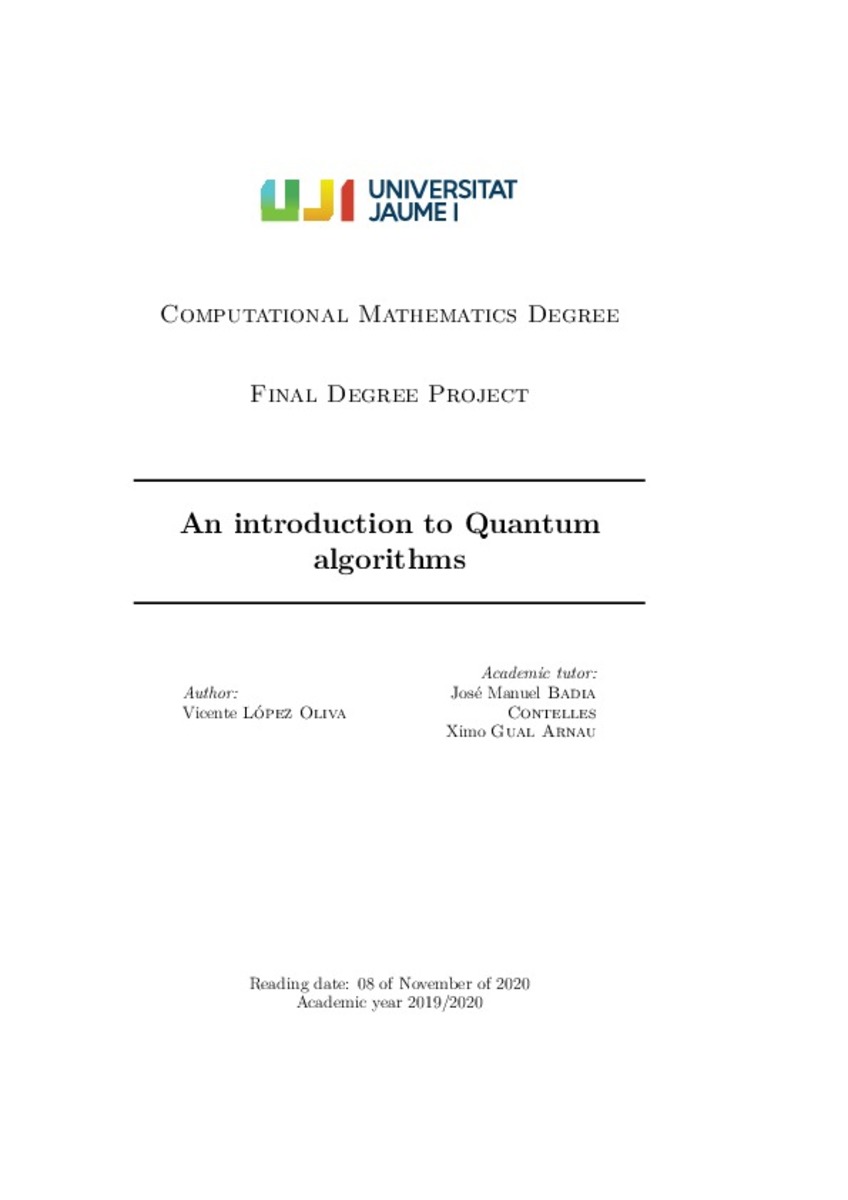Mostrar el registro sencillo del ítem
An introduction to Quantum algorithms
| dc.contributor.author | López Oliva, Vicente | |
| dc.contributor.other | Badia Contelles, José Manuel | |
| dc.contributor.other | Universitat Jaume I. Departament d'Enginyeria i Ciència dels Computadors | |
| dc.contributor.other | Gual-Arnau, Ximo | |
| dc.contributor.other | Universitat Jaume I. Departament de Matemàtiques | |
| dc.date.accessioned | 2021-02-23T12:07:30Z | |
| dc.date.available | 2021-02-23T12:07:30Z | |
| dc.date.issued | 2020-11-26 | |
| dc.identifier.uri | http://hdl.handle.net/10234/192218 | |
| dc.description | Treball Final de Grau en Matemàtica Computacional. Codi: MT1030. Curs: 2019/2020 | ca_CA |
| dc.description.abstract | Nowadays, we have powerful computers capable of performing very complex operations in seconds. However, there are problems that cannot be addressed at reasonable execution times, such as NP-Complete problems. For these problems no polynomial solution is known, having all of them exponential cost, which makes them unfeasible for classical computers. Quantum properties have impressed equally to computer scientists, physicist and all kinds of scientists since they were discovered, since they are very unintuitive. However, these properties, such as entanglement or superposition, lead us to have quantum computers and quantum algorithms that are able to solve in polynomial time some of the NP-Complete problems. This would be a breakthrough in fields with high computational demands such as machine learning, medicine, chemistry, etc. In this work, we will focus on knowing the computing mathematical basis that will allow us to study the complex quantum world, which includes, among other things, complex vector spaces and complex algebra. We will study the properties offered by the quantum computing world, such as the superposition of states or entanglement. We will also see quantum gates that will allow us to build quantum circuits to be able to create algorithms that we can execute on our quantum computers. We will finish the work by studying some well knows algorithms which will allow us to see how to take advantage of the quantum properties to accelerate our computing capacity | ca_CA |
| dc.format.extent | 85 p. | ca_CA |
| dc.format.mimetype | application/pdf | ca_CA |
| dc.language.iso | eng | ca_CA |
| dc.publisher | Universitat Jaume I | ca_CA |
| dc.rights | Atribución-CompartirIgual 4.0 Internacional | * |
| dc.rights.uri | http://creativecommons.org/licenses/by-sa/4.0/ | * |
| dc.subject | Grau en Matemàtica Computacional | ca_CA |
| dc.subject | Grado en Matemática Computacional | ca_CA |
| dc.subject | Bachelor's Degree in Computational Mathematics | ca_CA |
| dc.subject | complex vector space | ca_CA |
| dc.subject | Hilbert space | ca_CA |
| dc.subject | complex algebra | ca_CA |
| dc.subject | quantum computing | ca_CA |
| dc.subject | quantum algorithms | ca_CA |
| dc.subject | quantum teleportation | ca_CA |
| dc.subject | Deutch’s algorithm | ca_CA |
| dc.title | An introduction to Quantum algorithms | ca_CA |
| dc.type | info:eu-repo/semantics/bachelorThesis | ca_CA |
| dc.educationLevel | Estudios de Grado | ca_CA |
| dc.rights.accessRights | info:eu-repo/semantics/openAccess | ca_CA |
Ficheros en el ítem
Este ítem aparece en la(s) siguiente(s) colección(ones)
-
Grau en Matemàtica Computacional [99]
MT1030; MT1054








